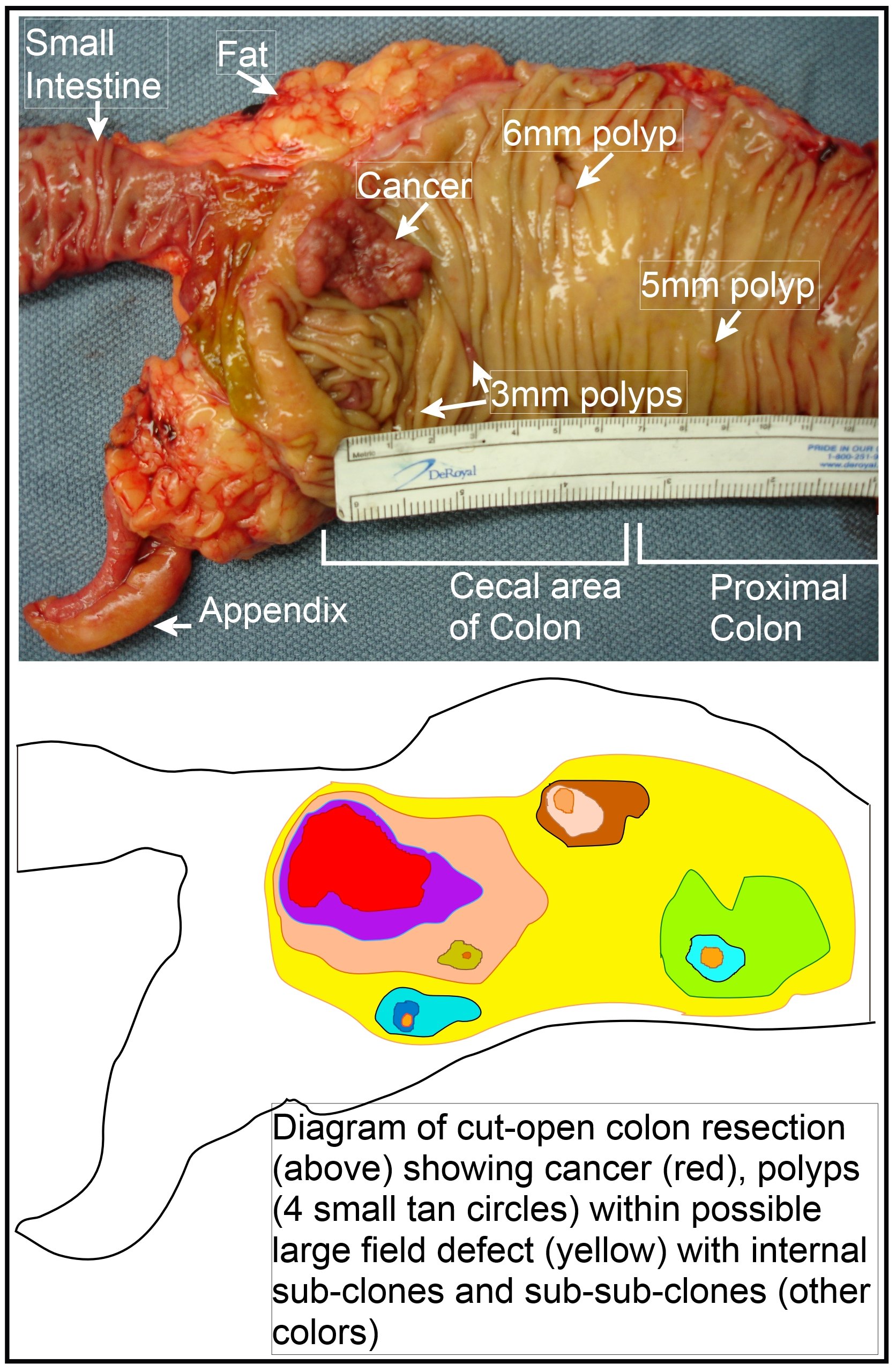Colon polyps pathophysiology: Difference between revisions
| Line 85: | Line 85: | ||
*There has been some association with familial juvenile polyposis and the [[gene]] SMAD4 on [[chromosome]] 18 and PTEN on chromosome 10 | *There has been some association with familial juvenile polyposis and the [[gene]] SMAD4 on [[chromosome]] 18 and PTEN on chromosome 10 | ||
==Gross Pathology== | ==Gross Pathology== | ||
Revision as of 05:32, 22 January 2018
|
Colon polyps Microchapters |
|
Diagnosis |
|---|
|
Treatment |
|
Case Studies |
|
Colon polyps pathophysiology On the Web |
|
American Roentgen Ray Society Images of Colon polyps pathophysiology |
|
Risk calculators and risk factors for Colon polyps pathophysiology |
Editor-In-Chief: C. Michael Gibson, M.S., M.D. [1]; Associate Editor(s)-in-Chief: Sadaf Sharfaei M.D.[2]
Overview
The exact pathogenesis of [disease name] is not fully understood.
OR
It is thought that [disease name] is the result of / is mediated by / is produced by / is caused by either [hypothesis 1], [hypothesis 2], or [hypothesis 3].
OR
[Pathogen name] is usually transmitted via the [transmission route] route to the human host.
OR
Following transmission/ingestion, the [pathogen] uses the [entry site] to invade the [cell name] cell.
OR
[Disease or malignancy name] arises from [cell name]s, which are [cell type] cells that are normally involved in [function of cells].
OR
The progression to [disease name] usually involves the [molecular pathway].
OR
The pathophysiology of [disease/malignancy] depends on the histological subtype.
Pathophysiology
Pathogenesis
- Any form of unregulated growth in the colon may cause polyps. The exact etiology is unclear. However, risk factors may contribute to the formation of polyps.
- There are four different types of polyps including inflammatory, hamartomatous, serrated, and adenomatous polyps, which have different pathogenesis.
- The pathophysiology of colon polyps depends on the histological type.
- It is thought that colon polyps is mediated by either [hypothesis 2], or [hypothesis 3].
Inflammatory polyps
- Inflammatory polyps are non-neoplastic polyps that occur following intestinal inflammation, infections, or ischemia.[1][2]
- They mostly occur in patients with inflammatory bowel disease, mainly ulcerative colitis.
- They are considered as pseudopolyps which contain inflammatory infiltrations with distorted mucosa.
- It had no malignant potential. However, it is recommended to biopsy the lesion and surrounding mucosa.
- Microscopic pathology of biopsy shows mixture of normal, ulcerated, and regenerating mucosa which is surrounded by areas of mucosal loss.
Hamartomatous polyps
- Hamartomatous polyp is an overgrowth of mature cells and connective tissue elements including smooth muscle, lamina propria, and cartilage, and fat. They are covered by a hypertrophic epithelium.[3]
- They might be pedunculated, inflamed, or smooth polyps which are solitary or multiple.
- Solitary hamartomatous polyps, also known as juvenile polyps, can present more commonly in younger population.
- Solitary polyps has no significant risk of cancer. However, multiple polyps of the colon have a 10% risk of malignancy.
Serrated polyps
- Serrated polyps are different polyps which have variable malignant potential. They include hyperplastic, sessile serrated and traditional serrated polyps. They have various histopathologies and manifestations.
- Hyperplastic polyps are the most common polyps. They are small outpouching, less than 5 mm, which are located mostly in rectosigmoid area. Hyperplastic polyp is infolding of the crypt epithelium that forms serration or saw-toothed appearance. The molecular basis of this transformation is still unclear. However, it has been attributed to failure of apoptosis.
- Serration
- BRAF mutation
- KRAS mutation
- Sessile serrated polyps
- Traditional serrated adenomas
Adenomatous polyps
Genetics
- The development of colon polyps is the result of multiple genetic mutations.
- Genetic mutations might cause hereditary polyps disorders.
Hereditary nonpolyposis colorectal cancer (Lynch syndrome)
Familial adenomatous polyposis (FAP)
Gardner's syndrome
MYH-associated polyposis (MAP)
- It is caused by mutations in the MYH gene.
- They develop multiple adenomatous polyps and colon cancer at a young age.
Peutz-Jeghers syndrome
Serrated polyposis syndrome
- They develop multiple serrated adenomatous polyps in the upper part of the colon.
- There has been some association with familial juvenile polyposis and the gene SMAD4 on chromosome 18 and PTEN on chromosome 10
Gross Pathology
- On gross pathology, [feature1], [feature2], and [feature3] are characteristic findings of [disease name].
 |
Microscopic Pathology
- On microscopic histopathological analysis, [feature1], [feature2], and [feature3] are characteristic findings of [disease name].
References
- ↑ Shussman, N.; Wexner, S. D. (2014). "Colorectal polyps and polyposis syndromes". Gastroenterology Report. 2 (1): 1–15. doi:10.1093/gastro/got041. ISSN 2052-0034.
- ↑ Li SC, Burgart L (2007). "Histopathology of serrated adenoma, its variants, and differentiation from conventional adenomatous and hyperplastic polyps". Arch. Pathol. Lab. Med. 131 (3): 440–5. doi:10.1043/1543-2165(2007)131[440:HOSAIV]2.0.CO;2. PMID 17516746.
- ↑ Zbuk KM, Eng C (2007). "Hamartomatous polyposis syndromes". Nat Clin Pract Gastroenterol Hepatol. 4 (9): 492–502. doi:10.1038/ncpgasthep0902. PMID 17768394.
- ↑ "File:Image of resected colon segment with cancer & 4 nearby polyps plus schematic of field defects with sub-clones.jpg - Wikimedia Commons".